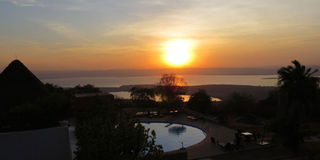The legend of Akagera

Sunset over Akagera National Park. PHOTO | RUPI MANGAT
What you need to know:
- After the park had been ransacked during the genocide, all seemed lost. One newspaper reporter from Europe even wrote an article of how the abandoned lodge was overrun by gorillas and titled the piece – Planet of the Apes. Instead the gorillas turned out to be baboons which were everywhere –in the bar, the rooms and swimming pool.
- And then sanity returned. Akagera National Park was re-gazetted in 1997. The lodge which was overrun by baboons is now the posh Akagera Lodge where we’re enjoying sun-downers overlooking River Kagera and many hills and plains.
On the sun-baked dry plains of the Akagera National Park in north-eastern Rwanda, an elephant emerges from the surrounding bushes. He is red like the soil, and huge.
“That’s Mutwara,” says the park ranger. “He is 50 years old. He was born here and lived through the genocide and the different wars. Everyone respects him,” he adds.
Mutwara – who has no tusks – had a special rapport with a man simply known as Boniface and the villagers living around Akagera. Then the genocide happened and Boniface fled and Mutwara was left alone to fend for himself.
“Look at his ears,” the ranger continues. They have a few holes – bullet holes. “The poachers came and tried to shoot Mutwara dead but he survived.”
Mutwara became fearful of people and stayed hidden outwitting the poachers while almost every other animal in the park, including all the lions, were killed. By the late 1990s, the poachers were in control of Akagera. The park became overrun with cattle and all seemed lost.
Until sanity returned. And 15 years later, a much older Boniface returned and went looking for Mutwara, calling out to him repeatedly in Kinyarwanda.
In a larger than life story – almost like the epic Jungle Book by Rudyard Kipling – Mutwara recognised the voice of his human friend and came out of the bush. He then knelt down and carried him up with his trunk.
PROTECTING NATURE
Akagera is an interesting park. Established in 1934, it has mountains, plains and swamps, and is on the border looking into Tanzania. The 400-kilometre Kagera River flows through it, giving the park its name. Rising in the highlands of Burundi, Kagera is the largest single inflow into Lake Victoria flowing through Burundi, Rwanda, Uganda and Tanzania with many huge bridges straddling borders.
It forms the eastern boundary of the park, feeding into many swamps and lakes, the largest of which is Lake Ihema, creating the largest protected wetlands in central Africa.
We stop by a lush swamp along the Kagera River; it’s busy with pods of hippos and crocodiles – some in the rich blue waters and others lazing under the hot sun. The unmistakable cry of the African fish eagle pierces the air and looking up in the forest is the majestic bird. Herds of zebra and waterbuck linger by the swamp for a morning drink. We move on in search of the 14 lions somewhere in the park.
After the park had been ransacked during the genocide, all seemed lost. One newspaper reporter from Europe even wrote an article of how the abandoned lodge was overrun by gorillas and titled the piece – Planet of the Apes. Instead the gorillas turned out to be baboons which were everywhere –in the bar, the rooms and swimming pool.
And then sanity returned. Akagera National Park was re-gazetted in 1997. The lodge which was overrun by baboons is now the posh Akagera Lodge where we’re enjoying sun-downers overlooking River Kagera and many hills and plains.
With its star rising, there are plans to bring back the black rhino, the world’s most endangered mega-herbivore after a 10-year absence. This will complete Akagera’s Big Five.
“The main purpose of conservation is to protect habitats and biodiversity,” said the Rwandese Prime Minister Anastase Murekezi in Kigali during a symposium on conservation. “And that means protecting nature. Rwanda’s Vision 2020 is green growth and a climate resilient economy.”
It seems to be working. Driving into Kigali from Akagera, the country is a mosaic of hills and valleys without any trash or plastic-chocked rivers. In Kigali we enjoy the charm of the city – clean streets, beautiful roads and houses and the marvelous Kigali International Convention Centre that’s lit at night in a miasma of colours.
*****
Remarkable Rwanda
Kenyans don’t need a visa or passport to enter Rwanda. You just need a valid document like a national identity card and a yellow fever card, but re-confirm about the requirements before you visit. Rwanda is tiny – 26,338 square kilometres – so most places are within a 100-kilomtre radius of Kigali, the capital. At Kigali, visit the Gisozi Memorial Centre to learn about the genocide history.
You can also read The Bishop of Rwanda by John Rucyahana which narrates the descent into madness during the 1994 genocide and the remarkable story of reconciliation and rebuilding Rwanda. No visit to Rwanda is complete without seeing the famous mountain gorillas, so save up and shape up for the trip of a lifetime to see our nearest cousin at the Volcanoes National Park.




